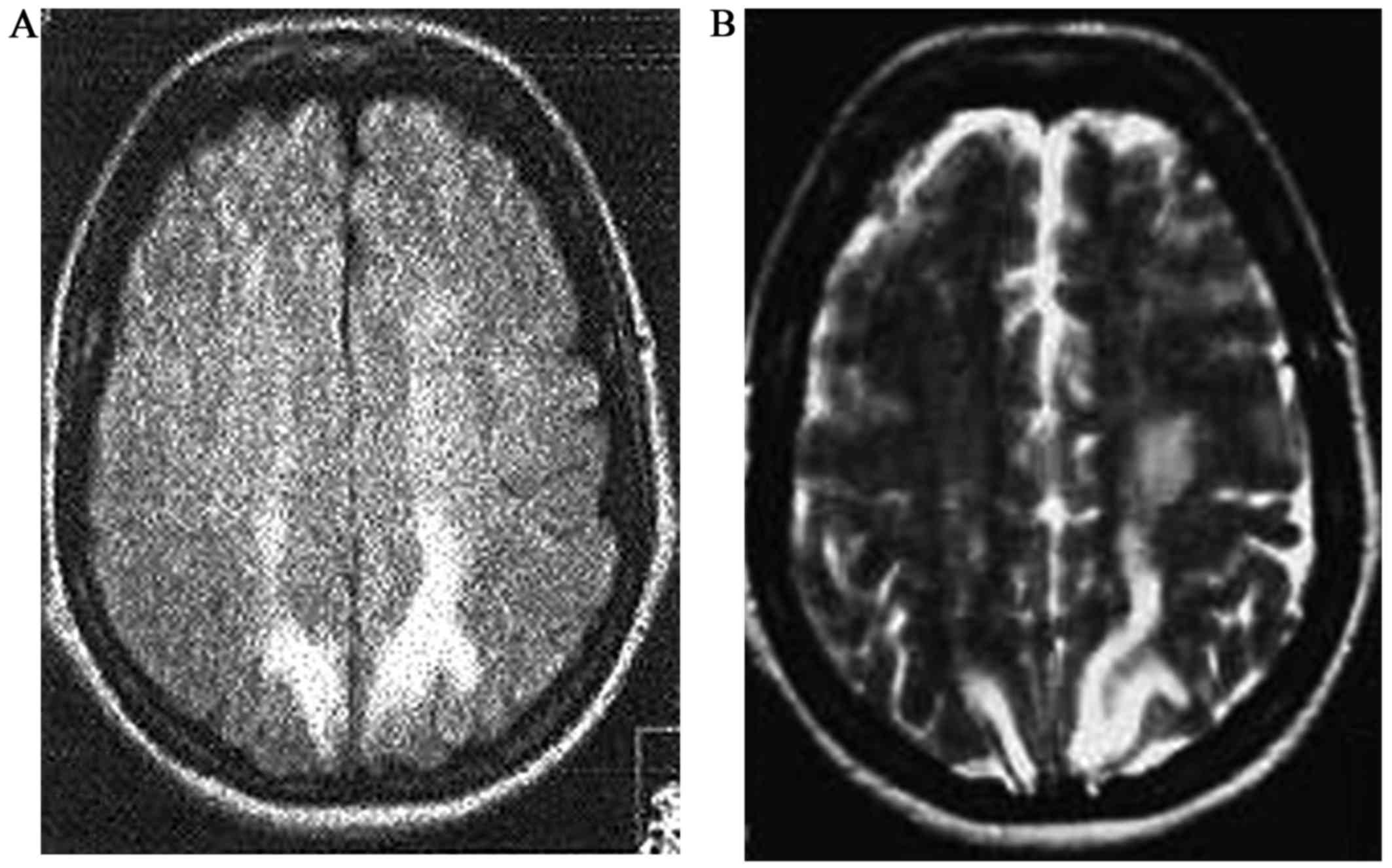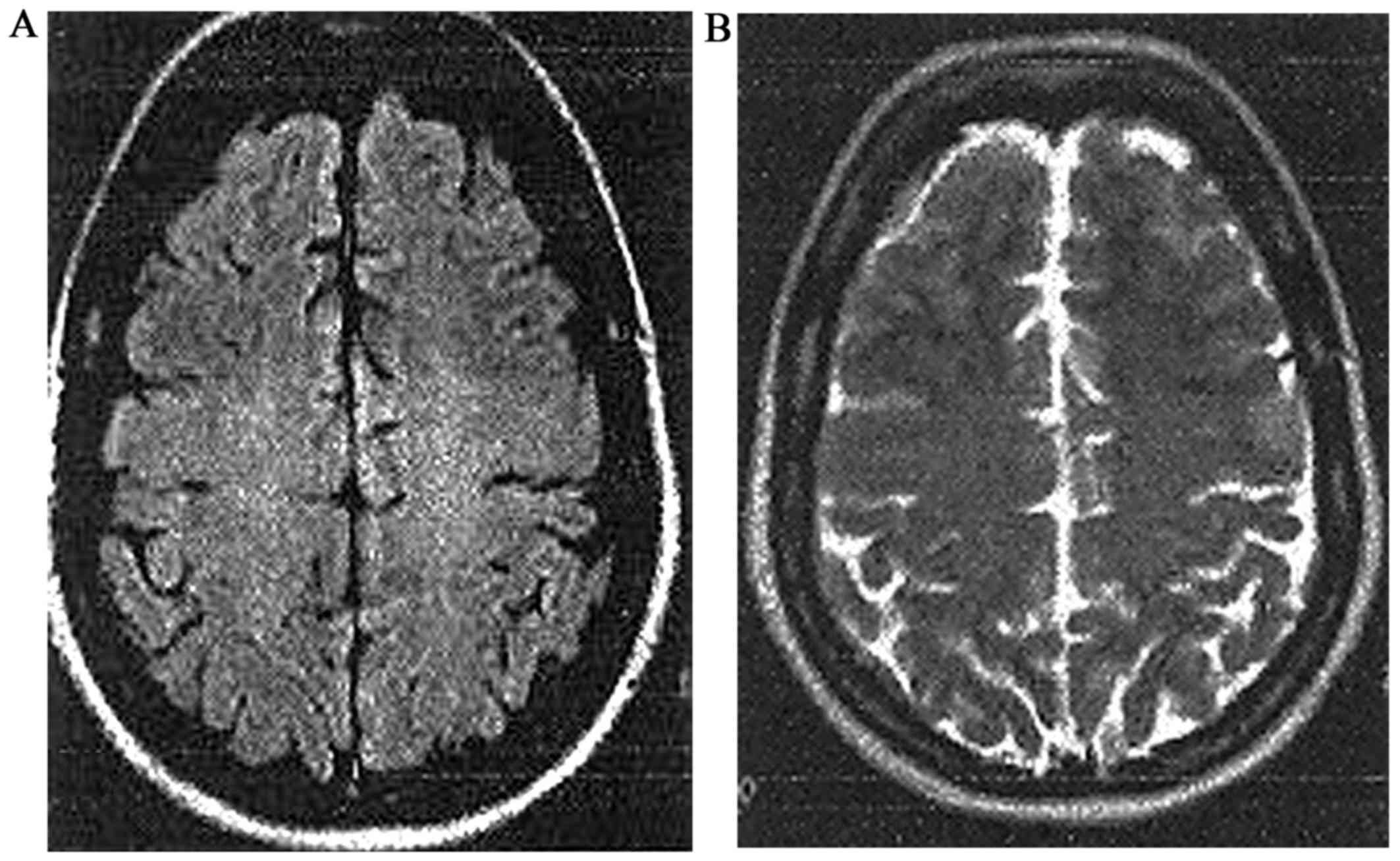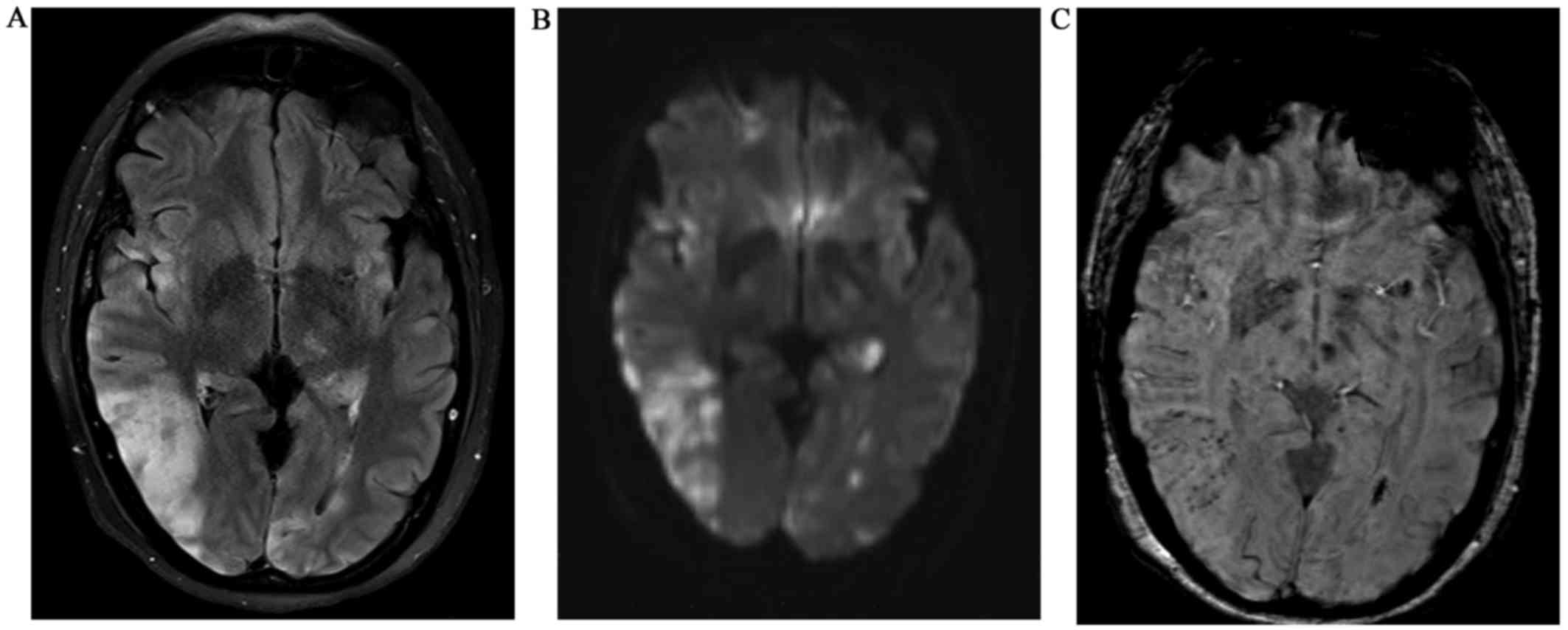|
1
|
Roth C and Ferbert A: The posterior
reversible encephalopathy syndrome: what's certain, what's new?
Pract Neurol. 11:136–144. 2011. View Article : Google Scholar : PubMed/NCBI
|
|
2
|
Hinchey J, Chaves C, Appignani B, Breen J,
Pao L, Wang A, Pessin MS, Lamy C, Mas JL and Caplan LR: A
reversible posterior leukoencephalopathy syndrome. N Engl J Med.
334:494–500. 1996. View Article : Google Scholar : PubMed/NCBI
|
|
3
|
Strandgaard S and Paulson OB: Cerebral
autoregulation. Stroke. 15:413–416. 1984. View Article : Google Scholar : PubMed/NCBI
|
|
4
|
Ozcan C, Wong SJ and Hari P: Reversible
posterior leukoencephalopathy syndrome and bevacizumab. N Engl J
Med. 354:980–982; discussion 980–982. 2006. View Article : Google Scholar : PubMed/NCBI
|
|
5
|
Allen JA, Adlakha A and Bergethon PR:
Reversible posterior leukoencephalopathy syndrome after
bevacizumab/FOLFIRI regimen for metastatic colon cancer. Arch
Neurol. 63:1475–1478. 2006. View Article : Google Scholar : PubMed/NCBI
|
|
6
|
Bodkin CL and Eidelman BH:
Sirolimus-induced posterior reversible encephalopathy. Neurology.
68:2039–2040. 2007. View Article : Google Scholar : PubMed/NCBI
|
|
7
|
Rajasekhar A and George TJ:
Gemcitabine-induced reversible posterior leukoencephalopathy
syndrome: a case report and review of the literature. Oncologist.
12:1332–1335. 2007. View Article : Google Scholar : PubMed/NCBI
|
|
8
|
Junna MR and Rabinstein AA: Tacrolimus
induced leukoencephalopathy presenting with status epilepticus and
prolonged coma. J Neurol Neurosurg Psychiatry. 78:1410–1411. 2007.
View Article : Google Scholar : PubMed/NCBI
|
|
9
|
Kozak OS, Wijdicks EF, Manno EM, Miley JT
and Rabinstein AA: Status epilepticus as initial manifestation of
posterior reversible encephalopathy syndrome. Neurology.
69:894–897. 2007. View Article : Google Scholar : PubMed/NCBI
|
|
10
|
Stott VL, Hurrell MA and Anderson TJ:
Reversible posterior leukoencephalopathy syndrome: a misnomer
reviewed. Intern Med J. 35:83–90. 2005. View Article : Google Scholar : PubMed/NCBI
|
|
11
|
George JN and Nester CM: Syndromes of
thrombotic microangiopathy. New England Journal of Medicine.
371:654–666. 2014. View Article : Google Scholar : PubMed/NCBI
|
|
12
|
Kwon S, Koo J and Lee S: Clinical spectrum
of reversible posterior leukoencephalopathy syndrome. Pediatric
Neurology. 24:361–364. 2001. View Article : Google Scholar : PubMed/NCBI
|
|
13
|
Bhat RA, Wani Z, Baasit S and Khan I:
Clinical course, laboratory parameters and outcome of TTP pediatric
patients presenting with posterior reversible encephalopathy
syndrome. Renal failure. 37:1–979. 2015. View Article : Google Scholar : PubMed/NCBI
|
|
14
|
Covarrubias DJ, Luetmer PH and Campeau NG:
Posterior reversible encephalopathy syndrome: prognostic utility of
quantitative diffusion-weighted MR images. Am J Neuroradiol.
23:1–1048. 2002.PubMed/NCBI
|
|
15
|
Al-Nouri ZL, Reese JA, Terrell DR, Vesely
SK and George JN: Drug-induced thrombotic microangiopathy: a
systematic review of published reports. Blood. 125:1–618. 2015.
View Article : Google Scholar : PubMed/NCBI
|
|
16
|
Valavaara R and Nordman E: Renal
complications of mitomycin-C therapy with special reference to the
total dose. Cancer. 55:1–50. 1985. View Article : Google Scholar : PubMed/NCBI
|
|
17
|
Reese JA, Bougie DW, Curtis BR, Terrell
DR, Vesely SK, Aster RH and George JN: Drug-induced thrombotic
microangiopathy: Experience of the Oklahoma registry and the
BloodCenter of Wisconsin. American Journal of Hematology.
90:406–410. 2015. View Article : Google Scholar : PubMed/NCBI
|
|
18
|
Groff JA, Kozak M, Boehmer JP, Demko TM
and Diamond JR: Endotheliopathy: a continuum of hemolytic uremic
syndrome due to mitomycin therapy. Am J Kidney Dis. 29:280–284.
1997. View Article : Google Scholar : PubMed/NCBI
|
|
19
|
Mistry B, Kimmel PL, Hetzel PC, Phillips
TM and Braden GL: The role of circulating immune complexes and
biocompatibility of staphylococcal protein A immunoadsorption in
mitomycin-C-induced hemolytic uremic syndrome. Am J Kidney Dis.
44:e50–58. 2004. View Article : Google Scholar : PubMed/NCBI
|
|
20
|
Russell MT, Nassif AS, Cacayorin ED, Awwad
E, Perman W and Dunphy F: Gemcitabine-associated posterior
reversible encephalopathy syndrome: MR imaging and MR spectroscopy
findings. Magn Reson Imaging. 19:129–132. 2001. View Article : Google Scholar : PubMed/NCBI
|
|
21
|
Larsen FO and Hansen SW: Severe
neurotoxicity caused by gemcitabine treatment. Acta Oncol.
43:590–591. 2004. View Article : Google Scholar : PubMed/NCBI
|
|
22
|
Govindarajan R, Adusumilli J, Baxter DL,
El-Khoueiry A and Harik SI: Reversible posterior
leukoencephalopathy syndrome induced by RAF kinase inhibitor BAY
43–9006. J Clin Oncol. 24:e48. 2006. View Article : Google Scholar : PubMed/NCBI
|
|
23
|
How J, Blattner M, Fowler S, Wang-Gillam A
and Schindler SE: Chemotherapy-associated posterior reversible
encephalopathy syndrome: a case report and review of the
literature. The neurologist. 21:112–117. 2016. View Article : Google Scholar : PubMed/NCBI
|
|
24
|
Cherniawsky H, Merchant N, Sawyer M and Ho
M: A case report of posterior reversible encephalopathy syndrome in
a patient receiving gemcitabine and cisplatin. Medicine.
96:e58502017. View Article : Google Scholar : PubMed/NCBI
|
|
25
|
Bhatt A, Farooq MU, Majid A and Kassab M:
Chemotherapy-related posterior reversible leukoencephalopathy
syndrome. Nat Rev Neurol. 5:1632009. View Article : Google Scholar
|
|
26
|
Truong QV, Abraham J, Nagaiah G, Newton M
and Veltri L: Gemcitabine associated with posterior reversible
encephalopathy syndrome (PRES): a case report and review of the
literature. Clin Adv Hematol Oncol. 10:611–613. 2012.PubMed/NCBI
|
|
27
|
Kabre RS and Kamble KM: Gemcitabine and
Cisplatin induced posterior reversible encephalopathy syndrome: A
case report with review of literature. J Res Pharm Pract.
5:297–300. 2016. View Article : Google Scholar : PubMed/NCBI
|
|
28
|
Baker WJ, Royer GL Jr and Weiss RB:
Cytarabine and neurologic toxicity. J Clin Oncol. 9:679–693. 1991.
View Article : Google Scholar : PubMed/NCBI
|
|
29
|
Ito Y, Arahata Y, Goto Y, Hirayama M,
Nagamutsu M, Yasuda T, Yanagi T and Sobue G: Cisplatin
neurotoxicity presenting as reversible posterior
leukoencephalopathy syndrome. Am J Neuroradiol. 19:415–417.
1998.PubMed/NCBI
|
|
30
|
Beck WT and Kuttesch JF: Neurological
symptoms associated with cyclosporin plus doxorubicin. Lancet.
340:4961992. View Article : Google Scholar : PubMed/NCBI
|
|
31
|
Walter RB, Joerger M and Pestalozzi BC:
Gemcitabine-associated hemolytic-uremic syndrome. Am J Kidney Dis.
40:e16.1–e16.6. 2002. View Article : Google Scholar
|
|
32
|
Bharthuar A, Egloff L, Becker J, George M,
Lohr JW, Deeb G and Iyer RV: Rituximab-based therapy for
gemcitabine-induced hemolytic uremic syndrome in a patient with
metastatic pancreatic adenocarcinoma: a case report. Cancer
Chemother Pharmacol. 64:177–181. 2009. View Article : Google Scholar : PubMed/NCBI
|
|
33
|
Muller S, Schutt P, Bojko P, Nowrousian
MR, Hense J, Seeber S and Moritz T: Hemolytic uremic syndrome
following prolonged gemcitabine therapy: report of four cases from
a single institution. Ann Hematol. 84:110–114. 2005. View Article : Google Scholar : PubMed/NCBI
|
|
34
|
Walter RB, Joerger M and Pestalozzi BC:
Gemcitabine-associated hemolytic-uremic syndrome. Am J Kidney Dis.
40:e162002. View Article : Google Scholar : PubMed/NCBI
|
|
35
|
Fung MC, Storniolo AM, Nguyen B, Arning M,
Brookfield W and Vigil J: A review of hemolytic uremic syndrome in
patients treated with gemcitabine therapy. Cancer. 85:2023–2032.
1999. View Article : Google Scholar : PubMed/NCBI
|
|
36
|
Starck M and Wendtner CM: Use of
eculizumab in refractory gemcitabine-induced thrombotic
microangiopathy. Br J Haematol. 164:894–896. 2013. View Article : Google Scholar
|
|
37
|
Turner JL, Reardon J, Bekaii-Saab T,
Cataland SR and Arango MJ: Gemcitabine-associated thrombotic
microangiopathy: response to complement inhibition and reinitiation
of gemcitabine. Clin Colorectal Cancer. 16:e119–e122. 2016.
View Article : Google Scholar
|
|
38
|
Rogier T, Gerfaud-Valentin M,
Pouteil-Noble C, Taleb A, Guillet M, Noel A, Broussolle C and Seve
P: Clinical efficacy of eculizumab as treatment of
gemcitabine-induced thrombotic microangiopathy: A case report. Rev
Med Interne. 37:701–704. 2016. View Article : Google Scholar : PubMed/NCBI
|
|
39
|
Gore EM, Jones BS and Marques MB: Is
therapeutic plasma exchange indicated for patients with
gemcitabine-induced hemolytic uremic syndrome? J Clin Apher.
24:209–214. 2009. View Article : Google Scholar : PubMed/NCBI
|
|
40
|
Ay H, Buonanno FS, Schaefer PW, Le DA,
Wang B, Gonzalez G and Koroshetz WJ: Posterior leukoencephalopathy
without severe hypertension: utility of diffusion-weighted MRI.
Neurology. 51:1369–1376. 1998. View Article : Google Scholar : PubMed/NCBI
|
|
41
|
Lv C and Gao B: Serum lactate
dehydrogenase as a predictor of outcome in posterior reversible
encephalopathy syndrome: imperative to unify. Am J Neuroradiol.
36:e29–e30. 2015. View Article : Google Scholar : PubMed/NCBI
|

















